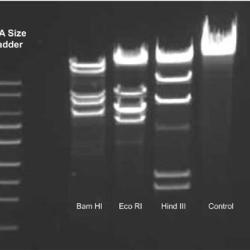Source Institutions
Source Institutions
Add to list Go to activity
Activity link broken? See if it's at the internet archive

In this activity related to plant biotechnology, learners use restriction enzymes to cut up DNA from a virus called Bacteriophage λ, a process known as restriction digestion. After overnight digestion, the reaction is stopped by addition of a loading buffer. The DNA fragments are separated by electrophoresis, a process that involves application of an electric field to cause the DNA fragments to migrate into an agarose gel. The gel is then stained with a methylene blue stain to visualize the DNA bands and may be photographed. This lab will help learners understand what a DNA restriction enzyme is and how it works, how to use a micropipette, how to separate DNA using electrophoresis, and how to use a restriction digestion map to identify a sample DNA. This lesson guide includes background information, safety precautions and notes, and questions with answers for learners. For safety reasons, adult supervision is recommended.
- 1 to 7 days
- 1 to 7 days
- Over $20 per group of students
- Ages 11 - adult
- Activity, Experiment/Lab Activity, Lesson/Lesson Plan
- English
Quick Guide
Materials List (per group of students)
- Four microtubes
- Microtube rack
- 20-µl micropipette (or 10-µl micropipette) and sterile tips
- Waterproof pen
- Beakers or foam cups with crushed ice
- 20 µl of 0.4 µg/µl λ DNA
- 2.5 µl BamHI restriction enzyme
- 2.5 µl EcoRI restriction enzyme
- 2.5 µl HindIII restriction enzyme
- 10 µl distilled water
- Gloves
- 500-ml beaker
- Electrophoresis chamber
- Power supply
- 20 µl 10X loading dye
- 1.0% agarose gel
- Container with TBE solution
- 37°C water bath w/ floating rack
- 60°C water bath or saucepan on a hot plate
- Cooler with crushed ice
- Freezer (non frost-free, if possible)
- Camera if desired
- Distilled water
- 0.002% methylene blue stain
Subjects
-
Engineering and Technology
-
Engineering
- Bioengineering/Biomedical Engineering
-
Technology
- Agriculture and Biotechnology
-
Engineering
-
Life Sciences
-
Cells
- Cell Structure and Function
-
Diversity of Life
- Viruses and Bacteria
-
Heredity and Genetics
- DNA Structure and Function
- Genetic Engineering
-
Cells
-
Physical Sciences
- Chemistry
-
The Nature of Science
-
The Scientific Process
- Conducting Investigations
- Gathering Data
- Formulating Explanations
- Communicating Results
-
The Scientific Process
Audience
To use this activity, learners need to:
- see
- see color
- read
- touch
Learning styles supported:
- Involves teamwork and communication skills
- Involves hands-on or lab activities
Other
Components that are part of this resource:
- Gel Electrophoresis of Dyes Activity
- Student Activity: Restriction Enzyme Analysis - Methylene Blue stain
This resource is part of:
Access Rights:
- Free access
By:
- Stephens, Janice ; Leach, Jan
Rights:
- All rights reserved, The American Phytopathological Society, 2011
